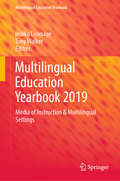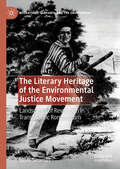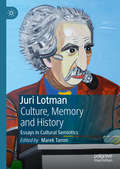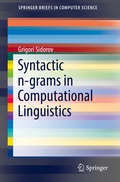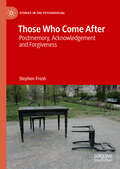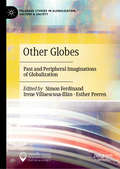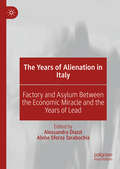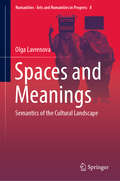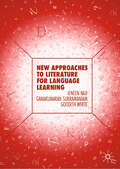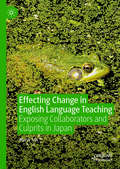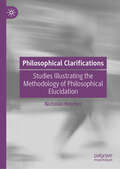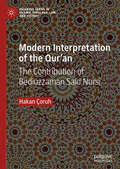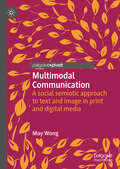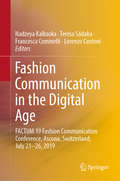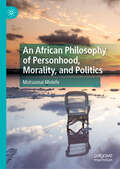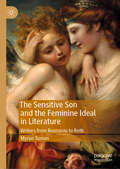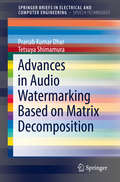- Table View
- List View
Multilingual Education Yearbook 2019: Media of Instruction & Multilingual Settings (Multilingual Education Yearbook)
by Indika Liyanage Tony WalkerThis book offers essential insights into the challenges and complexities surrounding the medium of instruction (MOI), its impact on all languages and stakeholders in multilingual contexts, educational processes, developments and outcomes. MOI has been a prominent topic in recent debates on the role of languages in education in multilingual contexts, partly because prioritizing one language over others as the medium of instruction has a profound impact on all languages and stakeholders in multilingual contexts. These include, to name but a few, (language) teachers, teacher educators, students, and policymakers, as well as industries and enterprises built around the needs and expectations of these stakeholders. This book presents high-quality empirical research on education in multilingual societies. It highlights research findings that, in addition to providing descriptions of language learning, development and use in language contact and multilingual contexts, will help shape future language education policy and practices in multilingual societies.
Contagion and the Shakespearean Stage (Palgrave Studies in Literature, Science and Medicine)
by Mary Floyd-Wilson Darryl ChalkThis collection of essays considers what constituted contagion in the minds of early moderns in the absence of modern germ theory. In a wide range of essays focused on early modern drama and the culture of theater, contributors explore how ideas of contagion not only inform representations of the senses (such as smell and touch) and emotions (such as disgust, pity, and shame) but also shape how people understood belief, narrative, and political agency. Epidemic thinking was not limited to medical inquiry or the narrow study of a particular disease. Shakespeare, Thomas Middleton, Ben Jonson, Thomas Dekker and other early modern writers understood that someone might be infected or transformed by the presence of others, through various kinds of exchange, or if exposed to certain ideas, practices, or environmental conditions. The discourse and concept of contagion provides a lens for understanding early modern theatrical performance, dramatic plots, and theater-going itself.
The Literary Heritage of the Environmental Justice Movement: Landscapes of Revolution in Transatlantic Romanticism (Literatures, Cultures, and the Environment)
by Lance NewmanThe Literary Heritage of the Environmental Justice Movement showcases environmental literature from writers who fought for women’s rights, native rights, workers’ power, and the abolition of slavery during the Romantic Era. Many Romantic texts take flight from society and enact solitary white male encounters with a feminine nature. However, the symbolic landscapes of Romanticism were often radicalized by writers like Olaudah Equiano, Frederick Douglass, William Apess, George Copway, Mary Wollstonecraft, Lydia Maria Child, John Clare, and Henry Thoreau. These authors showed how the oppression of human beings and the exploitation of nature are the twin driving forces of capitalism and colonialism. In addition to spotlighting new kinds of environmental literature, this book also reinterprets familiar texts by figures like William Blake, Nathaniel Hawthorne, Mary Shelley, William Wordsworth, and Walt Whitman, and it shows how these household figures were writing in conversation with their radical contemporaries.
Becoming Bilingual in School and Home in Tibetan Areas of China: Stories of Struggle (Multilingual Education #34)
by YiXi LaMuCuoThis book contributes significantly to our understanding of bilingualism and bilingual education as a sociocultural and political process by offering analyses of the stories of five Tibetan individual journeys of becoming bilingual in the Tibetan areas of China at four different points in time from 1950 to the present.The data presented comprises the narrative of their bilingual encounters, including their experiences of using language in their families, in village, and in school. Opportunities to develop bilingualism were intimately linked with historical and political events in the wider layers of experiences, which reveal the complexity of bilingualism. Moreover, their experiences of developing bilingualism are the stories of struggle to become bilingual. They struggle because they want to keep two languages in their lives. It illustrates their relationship with society. They are Tibetans. L1 is not the official language of their country, but it is the tie with their ethnicity. It addresses bilingualism linked with the formation of identity.The unique feature of this book is that it offers a deep understanding of bilingualism and bilingual education by examining the stories of five individuals’ learning experiences over a period of almost 60 years.
Juri Lotman - Culture, Memory and History: Essays in Cultural Semiotics
by Marek TammThis volume brings together a selection of Juri Lotman’s late essays, published between 1979 and 1995. While Lotman is widely read in the fields of semiotics and literary studies, his innovative ideas about history and memory remain relatively unknown. The articles in this volume, most of which are appearing in English for the first time, lay out Lotman’s semiotic model of culture, with its emphasis on mnemonic processes. Lotman’s concept of culture as the non-hereditary memory of a community that is in a continuous process of self-interpretation will be of interest to scholars working in cultural theory, memory studies and the theory of history.
Public History and Culture in South Africa: Memorialisation and Liberation Heritage Sites in Johannesburg and the Township Space (African Histories and Modernities)
by Ali Khangela Hlongwane Sifiso Mxolisi NdlovuThe post-apartheid era in South Africa has, in the space of nearly two decades, experienced a massive memory boom, manifest in a plethora of new memorials and museums and in the renaming of streets, buildings, cities and more across the country. This memorialisation is intricately linked to questions of power, liberation and public history in the making and remaking of the South African nation. Ali Khangela Hlongwane and Sifiso Mxolisi Ndlovu analyse an array of these liberation heritage sites, including the Hector Pieterson Memorial and Museum, the June 16, 1976 Interpretation Centre, the Apartheid Museum and the Mandela House Museum, foregrounding the work of migrant workers, architects, visual artists and activists in the practice of memorialisation. As they argue, memorialisation has been integral to the process of state and nation formation from the pre-colonial era through the present day.
Syntactic n-grams in Computational Linguistics (SpringerBriefs in Computer Science)
by Grigori SidorovThis book is about a new approach in the field of computational linguistics related to the idea of constructing n-grams in non-linear manner, while the traditional approach consists in using the data from the surface structure of texts, i.e., the linear structure.In this book, we propose and systematize the concept of syntactic n-grams, which allows using syntactic information within the automatic text processing methods related to classification or clustering. It is a very interesting example of application of linguistic information in the automatic (computational) methods. Roughly speaking, the suggestion is to follow syntactic trees and construct n-grams based on paths in these trees. There are several types of non-linear n-grams; future work should determine, which types of n-grams are more useful in which natural language processing (NLP) tasks. This book is intended for specialists in the field of computational linguistics. However, we made an effort to explain in a clear manner how to use n-grams; we provide a large number of examples, and therefore we believe that the book is also useful for graduate students who already have some previous background in the field.
Those Who Come After: Postmemory, Acknowledgement and Forgiveness (Studies in the Psychosocial)
by Stephen FroshThis book explores the legacies of suffering in relation to ‘those who come after’ – the descendants of victims, survivors and perpetrators of traumatic events. It draws on recent discussions of ‘postmemory’ and ‘haunting’ that are concerned mainly with the transgenerational impact of personal and social trauma. It examines how we are connected to past events for which we have no direct responsibility yet in which we might in some way be ‘implicated’ and it asks how we might attain a position of active witnessing that helps resolve the suffering of others. Those Who Come After includes vivid accounts of witnessing from a variety of perspectives, ranging from Biblical and Jewish stories to contemporary art and music. The book draws on psychosocial studies and psychoanalysis to help make sense of this material and to develop an understanding of acknowledgment and responsibility that is both ethical and emancipatory. Those Who Come After will be of great interest to readers in psychosocial studies and psychoanalysis and to all who are concerned with the question of how to put past suffering to rest.
The End of the World in Medieval Thought and Spirituality (The New Middle Ages)
by Jessica A. Boon Eric Knibbs Erica GelserThis essay collection studies the Apocalypse and the end of the world, as these themes occupied the minds of biblical scholars, theologians, and ordinary people in Antiquity, the Middle Ages, and Early Modernity. It opens with an innovative series of studies on “Gendering the Apocalypse,” devoted to the texts and contexts of the apocalyptic through the lens of gender. A second section of essays studies the more traditional problem of “Apocalyptic Theory and Exegesis,” with a focus on authors such as Augustine of Hippo and Joachim of Fiore. A final series of essays extends the thematic scope to “The Eschaton in Political, Liturgical, and Literary Contexts.” In these essays, scholars of history, theology, and literature create a dialogue that considers how fear of the end of the world, among the most pervasive emotions in human experience, underlies a great part of Western cultural production.
Other Globes: Past and Peripheral Imaginations of Globalization (Palgrave Studies in Globalization, Culture and Society)
by Simon Ferdinand Irene Villaescusa-Illán Esther PeerenThis volume challenges dominant imaginations of globalization by highlighting alternative visions of the globe, world, earth, or planet that abound in cultural, social, and political practice. In the contemporary context of intensive globalization, ruthless geopolitics, and unabated environmental exploitation, these “other globes” offer paths for thinking anew the relations between people, polities, and the planet. Derived from disparate historical and cultural contexts, which include the Holy Roman Empire; late medieval Brabant; the (post)colonial Philippines; early twentieth-century Britain; contemporary Puerto Rico; occupied Palestine; postcolonial Africa and Chile; and present-day California, the past and peripheral globes analyzed in this volume reveal the variety of ways in which the global has been—and might be—imagined. As such, the fourteen contributions underline that there is no neutral, natural, or universal way of inhabiting the global.
The Years of Alienation in Italy: Factory and Asylum Between the Economic Miracle and the Years of Lead
by Alessandra Diazzi Alvise Sforza TarabochiaThe Years of Alienation in Italy offers an interdisciplinary overview of the socio-political, psychological, philosophical, and cultural meanings that the notion of alienation took on in Italy between the 1960s and the 1970s. It addresses alienation as a social condition of estrangement caused by the capitalist system, a pathological state of the mind and an ontological condition of subjectivity. Contributors to the edited volume explore the pervasive influence this multifarious concept had on literature, cinema, architecture, and photography in Italy. The collection also theoretically reassesses the notion of alienation from a novel perspective, employing Italy as a paradigmatic case study in its pioneering role in the revolution of mental health care and factory work during these two decades.
Spaces and Meanings: Semantics of the Cultural Landscape (Numanities - Arts and Humanities in Progress #8)
by Olga LavrenovaThis book examines the problem of relationships between culture and space. Highlighting the use of semiotics of culture as a basic concept of research, it describes the power of the cultural landscape in the context of culture philosophical research. Opening with a discussion of the existence of culture in space, it establishes basic concepts such as noosphere and pneumatosphere. The author acknowledges the early contributions of thinkers like Vladimir Vernadsky and Pierre Teilhard de Chardin, who first observed that human activity has become a geological force.Introducing time and space to the discussion, the author then describes the nature of mythological time, eternity versus timelessness, and the semantics of sacred landscapes, space and ritual. These concepts are further developed in discussions of the metaphorical nature of cultural landscape, and the city as metaphor.The book explores semiotics in the cultural landscape, examining the genesis of concepts from geographical images to signs and the axiological dimension of geographical images. In her approach to the idea of cultural landscape as text, she provides detailed examples, including the Russian landscape as agent provocateur of the text, and the culture philosophical aspects and semantics of travel.It establishes the cultural landscape as a phenomenon of culture that is fixed in geographical space with the help of semiotic mechanisms—a specific area of culture of life possessing functional and ontological self-sufficiency.This book appeals readers and researchers interested in the philosophy of culture, semiotics of space, and the philosophical dimensions of culture and geography.
New Approaches to Literature for Language Learning
by Jeneen Naji Ganakumaran Subramaniam Goodith WhiteThis book unpacks recent changes in the landscape of literature and language teaching, and aims to find new explanations for the altered relationships between readers and writers, the democratisation of authorship, and the emergence of new ways of using language. By examining topics as various as literature and technology, multimodality, and new Englishes, the authors take a fresh look at the use of literature as a tool in the teaching of English to second-language speakers. More than simply a way of teaching aesthetic and ethical values and rhetorical skills, they argue that literature can also be used to help students to critically evaluate assumptions about society, culture and power which underpin the production and reception of texts. The book relates theories of language acquisition and literary criticism to examples of literary texts from a wide range of global literature in English, and discusses new ways of engaging with it, such as transmedia story telling, book blogs and slam poetry. It will be of interest to language teachers and teacher trainers, and to students and scholars of applied linguistics, TESOL, and digital literacies.
Effecting Change in English Language Teaching: Exposing Collaborators and Culprits in Japan
by Glenn TohThis book is about the challenges that come with initiatives to develop a more humanized, intersectional and negotiable landscape for English Language Teaching (ELT). It sets out to problematize ingrown and ingrained practices in English teaching, weaving together obscured practices, undisclosed agendas and ideologically motivated (inter)actions to expose the unspoken agendas at work. Drawing on his own experience of being part of an English as a Lingua Franca (ELF) programme at an urban Japanese university, the author presents a case for rethinking language education in Japan. This book will be of interest to applied linguists, language teachers and teacher trainers, cultural anthropologists, and anyone interested in the cultural politics of education, especially language education.
Philosophical Clarifications: Studies Illustrating the Methodology of Philosophical Elucidation
by Nicholas RescherThis book is an integrated series of philosophical investigations that offers significant new insights into key philosophical concerns ranging from methodological issues to substantive doctrines. Consisting of three sections, it first deals with the nature of philosophizing itself and seeks to illustrate the project from the angle of the pragmatic tradition. The second section is devoted to issues of knowledge and how the cognitive project goes about producing results that are cogent and objective. The third and closing section considers how the ideas and perspectives of these considerations can be applied and implemented in various matters of personal judgment and practice.
Experimentation and the Lyric in Contemporary French Poetry: Poetry On The Edge (Palgrave Studies in Modern European Literature)
by Jeff BardaExperimentation and the Lyric in Contemporary French Poetry offers a new theoretical approach and historical perspective on the remarkable upsurge in creative poetic practices in France that have challenged traditional definitions of poetry and of the lyric. Focusing on the work of Pierre Alferi, Olivier Cadiot, Emmanuel Hocquard, Franck Leibovici, Anne Portugal and Denis Roche, this book provides an analysis of the most influential poets in French poetry of the last few decades. It contextualizes the theoretical models that inform their investigations, analyzing them alongside the history of the avant-garde and the heated theoretical debates that have taken place over whether to continue or bring an end to the lyric. Systematically addressing the various strategies employed by these poets and drawing on reception theory and cognitive studies, Jeff Barda argues that French radical poetics re-evaluates the lyric in cognitive terms beyond the personal. This book is essential reading for anyone interested in twenty-first-century forms of experimental writing and the connections between literature and the arts today.
Modern Interpretation of the Qur’an: The Contribution of Bediuzzaman Said Nursi (Palgrave Series in Islamic Theology, Law, and History)
by Hakan ÇoruhThis book analyzes the distinguished modern Muslim scholar Bediuzzaman Said Nursi and the methodology of Qur’anic exegesis in his Risale-i Nur Collection, with special reference to the views of the early Muslim modernist intellectuals such as Muhammad ‘Abduh. It seeks to locate Nursi within modern Qur’anic scholarship, exploring the difference between Nursi’s reading of the Qur’an and that of his counterparts, and examines how Nursi relates the Qur’anic text to concerns of the modern period.
Multimodal Communication: A social semiotic approach to text and image in print and digital media
by May WongThis book draws on visual data, ranging from advertisements to postage stamps to digital personal photography, to offer a complex interpretation of the different social functions realised by these texts as semiotic artefacts. Framed within the media environment of the city of Hong Kong, the study demonstrates the importance of social context to meaning making and social semiotic multimodal analysis. This book will be of interest to readers in the arts, humanities and social sciences, particularly within the fields of semiotics, visual studies, design studies, media and cultural studies, anthropology and sociology.
Fashion Communication in the Digital Age: FACTUM 19 Fashion Communication Conference, Ascona, Switzerland, July 21-26, 2019
by Nadzeya Kalbaska Teresa Sádaba Francesca Cominelli Lorenzo CantoniThis book represents a major milestone in the endeavour to understand how communication is impacting on the fashion industry and on societal fashion-related practices and values in the digital age. It presents the proceedings of FACTUM 19, the first in a series of fashion communication conferences that highlights important theoretical and empirical work in the field. Beyond documenting the latest scientific insights, the book is intended to foster the sharing of methodological approaches, expand the dialogue between communications’ studies and fashion-related disciplines, help establish an international and interdisciplinary network of scholars, and offer encouragement and fresh ideas to junior researchers. It is of high value to academics and students in the fields of fashion communication, fashion marketing, visual studies in fashion, digital transformation of the fashion industry, and the cultural heritage dimension of fashion. In addition, it is a key resource for professionals seeking sound research on fashion communication and marketing.
Artificial Companion for Second Language Conversation: Chatbots Support Practice Using Conversation Analysis
by Sviatlana HöhnThe research described in this book shows that conversation analysis can effectively model dialogue. Specifically, this work shows that the multidisciplinary field of communicative ICALL may greatly benefit from including Conversation Analysis. As a consequence, this research makes several contributions to the related research disciplines, such as conversation analysis, second-language acquisition, computer-mediated communication, artificial intelligence, and dialogue systems. The book will be of value for researchers and engineers in the areas of computational linguistics, intelligent assistants, and conversational interfaces.
An African Philosophy of Personhood, Morality, and Politics
by Motsamai MolefeThis book explores the salient ethical idea of personhood in African philosophy. It is a philosophical exposition that pursues the ethical and political consequences of the normative idea of personhood as a robust or even foundational ethical category. Personhood refers to the moral achievements of the moral agent usually captured in terms of a virtuous character, which have consequences for both morality and politics. The aim is not to argue for the plausibility of the ethical and political consequences of the idea of personhood. Rather, the book showcases some of the moral-political content and consequences of the account it presents.
Canadian Science Fiction, Fantasy, and Horror: Bridging the Solitudes (Studies in Global Science Fiction)
by Amy J. Ransom Dominick GraceCanadian Science Fiction, Fantasy, and Horror: Bridging the Solitudes exposes the limitations of the solitudes concept so often applied uncritically to the Canadian experience. This volume examines Canadian and Québécois literature of the fantastic across its genres—such as science fiction, fantasy, horror, indigenous futurism, and others—and considers how its interrogation of colonialism, nationalism, race, and gender works to bridge multiple solitudes. Utilizing a transnational lens, this volume reveals how the fantastic is ready-made for exploring, in non-literal terms, the complex and problematic nature of intercultural engagement.
Defining Literary Postmodernism for the Twenty-First Century
by Matthias StephanThis book presents a definition of literary postmodernism, using detective and science fictions as a frame. Through an exploration of both prior theoretical approaches, and indicators through characteristics of postmodernist fiction, this book identifies a structural framework to both understand and apply the lessons of postmodernism for the next generation. Within a growing consensus that the postmodern era has passed, this book examines the different conceptions of postmodernism and posits a meaningful definition, one which can provide the foundation for future literary expression. This theory is then applied to genre fiction, particularly detective fiction and science fiction, demonstrating that postmodernism is found in the structure, rather than questions posed about literary expression. Finally, Matthias Stephan considers post-postmodern movements, and how they can be expressed given this definition of literary postmodernism, moving forward to the twenty-first century.
The Sensitive Son and the Feminine Ideal in Literature: Writers from Rousseau to Roth
by Myron TumanThis book considers major male writers from the last three centuries whose relation to a strong, often distant woman—one sometimes modeled on their own mother—forms the romantic core of their greatest narratives. Myron Tuman explores the theory that there is an underlying psychological type, the sensitive son, connecting these otherwise diverse writers. The volume starts and ends with Jean-Jacques Rousseau, whose Confessions provides an early portrait of one such son. There are chapters on other adoring sons, Stendhal, Sacher-Masoch, Scott Fitzgerald, and Turgenev, as well as on sons like Bernard Shaw and D.H. Lawrence with a different, less affectionate psychological disposition toward women. This book demonstrates how, despite many differences, the best works of all these sensitive sons reflect the deep, contorted nature of their desire, a longing that often seems less for an actual woman than for an elusive feminine ideal.
Advances in Audio Watermarking Based on Matrix Decomposition (SpringerBriefs in Speech Technology)
by Pranab Kumar Dhar Tetsuya ShimamuraThis book introduces audio watermarking methods in transform domain based on matrix decomposition for copyright protection. Chapter 1 discusses the application and properties of digital watermarking. Chapter 2 proposes a blind lifting wavelet transform (LWT) based watermarking method using fast Walsh Hadamard transform (FWHT) and singular value decomposition (SVD) for audio copyright protection. Chapter 3 presents a blind audio watermarking method based on LWT and QR decomposition (QRD) for audio copyright protection. Chapter 4 introduces an audio watermarking algorithm based on FWHT and LU decomposition (LUD). Chapter 5 proposes an audio watermarking method based on LWT and Schur decomposition (SD). Chapter 6 explains in details on the challenges and future trends of audio watermarking in various application areas.Introduces audio watermarking methods for copyright protection and ownership protection;Describes watermarking methods with encryption and decryption that provide excellent performance in terms of imperceptibility, robustness, and data payload;Discusses in details on the challenges and future research direction of audio watermarking in various application areas.
